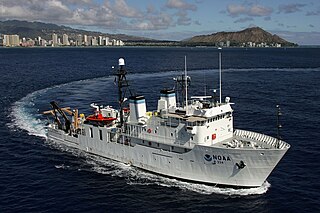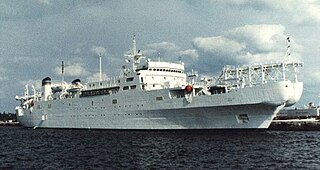
Deep Submergence Vessel NR-1 was a unique United States Navy (USN) nuclear-powered ocean engineering and research submarine, built by the Electric Boat Division of General Dynamics at Groton, Connecticut. NR-1 was launched on 25 January 1969, completed initial sea trials 19 August 1969, and was home-ported at Naval Submarine Base New London. NR-1 was the smallest nuclear submarine ever put into operation. The vessel was casually known as "Nerwin" and was never officially named or commissioned. The U.S. Navy is allocated a specific number of warships by the U.S. Congress, but Admiral Hyman Rickover avoided using one of those allocations for the construction of NR-1 in order to circumvent the oversight that a warship receives from various bureaus.
The Ship-Submarine Recycling Program (SRP) is the process that the United States Navy uses to dispose of decommissioned nuclear vessels. SRP takes place only at the Puget Sound Naval Shipyard (PSNS) in Bremerton, Washington, but the preparations can begin elsewhere.

Robert Duane Ballard is an American retired Navy officer and a professor of oceanography at the University of Rhode Island who is most noted for his work in underwater archaeology: maritime archaeology and archaeology of shipwrecks. He is best known for the discoveries of the wrecks of the RMS Titanic in 1985, the battleship Bismarck in 1989, and the aircraft carrier USS Yorktown in 1998. He discovered the wreck of John F. Kennedy's PT-109 in 2002 and visited Biuku Gasa and Eroni Kumana, who saved its crew.

USS Thresher (SSN-593) was the lead boat of her class of nuclear-powered attack submarines in the United States Navy. She was the U.S. Navy's second submarine to be named after the thresher shark.

USS Dolphin (AGSS-555) was a United States Navy diesel-electric deep-diving research and development submarine. She was commissioned in 1968 and decommissioned in 2007. Her 38-year career was the longest in history for a US Navy submarine to that point. She was the Navy's last operational conventionally powered submarine.

USS Grunion (SS-216) was a Gato-class submarine that sank at Kiska, Alaska, during World War II. She was the only ship of the United States Navy to be named for the grunion.

The Military Sealift Command (MSC) is an organization that controls the replenishment and military transport ships of the United States Navy. Military Sealift Command has the responsibility for providing sealift and ocean transportation for all US military services as well as for other government agencies. It first came into existence on 9 July 1949 when the Military Sea Transportation Service (MSTS) became solely responsible for the Department of Defense's ocean transport needs. The MSTS was renamed the Military Sealift Command in 1970.

A deep-submergence vehicle (DSV) is a deep-diving crewed submersible that is self-propelled. Several navies operate vehicles that can be accurately described as DSVs. DSVs are commonly divided into two types: research DSVs, which are used for exploration and surveying, and DSRVs, which are intended to be used for rescuing the crew of a sunken navy submarine, clandestine (espionage) missions, or both. DSRVs are equipped with docking chambers to allow personnel ingress and egress via a manhole.

RV Knorr was a research vessel formerly owned by the U.S. Navy and operated by the Woods Hole Oceanographic Institution for the U.S. research community in coordination with and as a part of the University-National Oceanographic Laboratory System (UNOLS) fleet. On March 14, 2016, Knorr was officially transferred to the Mexican Navy and renamed Rio Tecolutla. She was replaced at Woods Hole by the RV Neil Armstrong. Knorr is best known as the ship that supported researchers as they discovered the wreck of the RMS Titanic in 1985. R/V Knorr (AGOR-15) has traveled more than a million miles—the rough equivalent of two round trips to the Moon or forty trips around the Earth. Her sister ship is the RV Melville.

USNS Observation Island (T-AGM-23) was built as the Mariner-class merchant ship Empire State Mariner for the United States Maritime Commission, launched 15 August 1953, and operated by United States Lines upon delivery on 24 February 1954, making voyages for the Military Sea Transportation Service (MSTS) until going into reserve at Mobile, Alabama on 9 November 1954.

USNS Vindicator (T-AGOS-3) was a United States Navy Stalwart-class modified tactical auxiliary general ocean surveillance ship that was in service from 1984 to 1993. Vindicator then served in the United States Coast Guard from 1994 to 2001 as the medium endurance cutter USCGC Vindicator (WMEC-3). From 2004 to 2020, she was in commission in the National Oceanic and Atmospheric Administration (NOAA) fleet as the oceanographic research ship NOAAS Hi'ialakai.

USNS Capable (T-AGOS-16) was a Stalwart-class modified tactical auxiliary general ocean surveillance ship of the United States Navy in service from 1989 to 2004. In 2008, she was commissioned into service in the National Oceanic and Atmospheric Administration as the oceanographic research ship NOAAS Okeanos Explorer.
MV Kellie Chouest is a Deep Submergence Elevator Support Ship operated under the Military Sealift Command's Special Mission Ship Program and leased from Edison Chouest Offshore. It is assigned to COMSUBDEVRON FIVE for deep water rescue, salvage and research missions.

USS White Sands (ARD-20), ex-USS ARD-20, ex-USS ARD(BS)-20, later AGDS-1, was a United States Navy auxiliary repair dock in service from 1944 to 1947 and from 1966 to 1974 and an Auxiliary floating drydock.

USNS Navajo (T-ATF-169) was a United States Navy Powhatan-class tugboat operated by the Military Sealift Command which was in service from 1980 to 2016. She spent the bulk of her career in the Pacific and is currently moored in Pearl Harbor, awaiting disposal.

USNS Powhatan (T-ATF-166) was the lead ship of the United States Navy Powhatan-class fleet ocean tugboats. She was in service with the U.S. Navy from 1979 to 1999, and then was leased to a private towing and salvage company. At the end of the lease in 2008, the ship was sold to the Turkish Navy which recommissioned her as TCG Inebolu.

USNS Sioux (T-ATF-171) was a United States Navy Powhatan-class tugboat operated by the Military Sealift Command (MSC). She was in service from 1981 to 2021 and spent the bulk of this time supporting the Pacific Fleet.

USNS Zeus (T-ARC-7) is the first cable ship specifically built for the United States Navy. Though planned to be the first of two ships of her class, the second ship was not built, leaving Zeus as the only ship of her class. She is capable of laying 1,000 miles (1,600 km) of cable at depths of up to 9,000 feet (2,700 m).
















